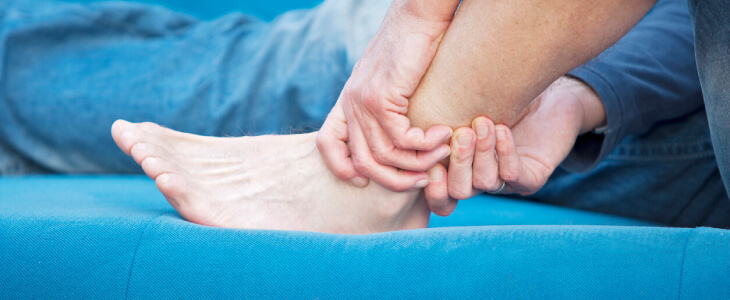At Long Island Spine Rehabilitation Medicine, we frequently see patients who have suffered ankle injuries or who are experiencing chronic ankle pain of unknown origin. If you are troubled by ankle pain, it is most likely interfering with your daily routine since our ankles bear the weight the minute we are upright. It is best to make an appointment at one of our convenient locations as soon as possible so that we can keep your condition from worsening, find out what’s going on, and treat you successfully.
Possible Causes of Ankle Pain
The ankle is a fairly complicated structure, built to bear our body weight and allow us to walk, run, jump, crouch, and pivot. It is comprised of an intricate network of bones, muscles, ligaments, and tendons. Because of this complexity, a number of things can go wrong in the ankle, often causing severe pain. Pain in the ankle may be felt on the outside or inside of the joint, or along the Achilles tendon, the tendon that connects the heel bone to the lower leg.
It’s important to see a doctor when you have ankle pain because there are so many possible causes for your suffering and treatment will, as always, depend upon an accurate diagnosis.
Possible causes of ankle pain include the following injuries and disease conditions:
- Rupture of the Achilles tendon
- Fracture of one of the bones of the ankle or foot
- Bursitis (inflammation of a bursa, a fluid-filled sac that cushions the joint)
- Tarsal tunnel syndrome (compression of the posterior tibial nerve)
- Osteoarthritis (wear and tear of the ankle bones due to aging or injury)
- Inflammatory arthritis (autoimmune disorders like rheumatoid or psoriatic arthritis,)
- Ankle sprain (stretching or tearing of a ligament)
Diagnosing Ankle Pain
Our doctors have multiple diagnostic methods available. Once they take a full medical history and perform a physical examination, they will use one or more of the methods listed below to confirm the overt and/or underlying cause of your pain:
- Imaging tests, such as X-rays, CT, MRI, or ultrasound scans
- Blood tests
- Diagnostic aspiration to examine synovial fluid at the joint
- Electromyography (EMG) and nerve conduction studies
Of course, your ankle pain may be due to a specific injury in which case the cause will usually be much easier to ferret out.
Common Ankle Injuries
Ankle injuries often occur during routine activities during which the patient tripped and fell, landed awkwardly after a jump, walked or ran on uneven surfaces, accidentally twisted, or rolled the ankle in an unnatural way. They also happen in traffic accidents when the patient collides with a part of the car or another passenger, is thrown from the car, or is a pedestrian directly impacted by a vehicle.
Other ankle injuries commonly occur during sports. In a study of high school athletes, the National Institutes of Health found that over 20 percent of sports injuries were injuries to the ankle and that such accidents most often happened in sports that combine jumping, running, and swift changes in direction (football, basketball, soccer, volleyball). The highest rates of ankle injury were found in boys’ basketball, girls’ basketball, and boys’ football, respectively. Interestingly, in most cases, ankle injuries were more frequent in actual competitions than during practice.
Treatment of Ankle Injuries
Once we have correctly diagnosed your ankle injury, our doctors have numerous nonsurgical treatment options available. In many cases, home remedies like resting the leg in an elevated position and applying ice packs can be very helpful. When injuries or disease conditions are more serious, we may recommend:
- Bracing or casting
- Use of assistive devices (e.g. canes or walking boots)
- Physical therapy to restore strength and range of motion
- Ultrasound-guided injections of a corticosteroid and analgesics
- PEMF (Pulsed Electromagnetic Field therapy) that treats pain and inflammation, as well as increasing blood flow
- Acupuncture
- Platelet-Rich Plasma (PRP) to promote healing
The sooner you contact us, the sooner we can begin alleviating your pain and accelerating the healing process.
